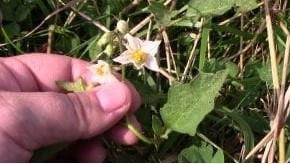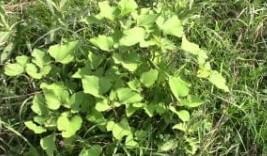By Christine Gelley
A couple pesky and prickly weeds that often go unnoticed until mid-summer in pastures and hayfields are common cocklebur and horsenettle. Both have the potential to cause toxicities if consumed in high enough amounts. As mentioned in prior articles, the most common situations where animals are poisoned by toxic plants occur when there isn’t enough good forage to eat. Overgrazed pastures or forced feeding of hay containing toxic plants are more often the cause of a poisoning than the plant itself. The amount of plant material that mut be consumed to create a negative reaction depends on the species, age, and stage of the animal and the plant.

Horsenettle is a member of the Solanaceae (tomato) family. It’s leaves and flowers are similar in appearance to tomatoes, except the leaf midvein on the underside of the leaf is lined with sharp spines. The berries of the plant will appear similar to yellow cherry tomatoes when mature. Although they look safe to eat, they are not. While all parts of the plant can be toxic, the berries are most problematic. Horsenettle is an opportunistic and persistent perennial plant.

Cocklebur, a growing concern in Ohio pastures, can be toxic to livestock.
Cocklebur is a summer annual weed from the Asteraceae (daisy) family. Unlike many of it’s relatives, cocklebur looks nothing like a daisy. The mature leaves of the plant look similar to the leaves of a sycamore tree, with irregularly lobed and toothed leaf margins. The flower it produces is usually unnoticed because it is green. The fruit it produces is a cluster of egg-shaped burs that easily catch on and hitch a ride on the hide of animals that pass by. Cocklebur can be especially damaging to animals with fiber value, such as sheep.
Neither plant is appealing from a grazing perspective due to the hairy leaves and prickly plant tissue, but extremely hungry animals or those without grazing experience may be tempted to taste them. Poisonings are more common when the plant tissue is unavoidable in hay. Although the drying process of haymaking reduces the toxins present in the plant tissue, they are not eliminated.
Mowing is not very effective for cocklebur or horsenettle due to their ability to flower and produce seed so low to the ground. Tillage can be tempting, but will often stir up additional weed seed in the soil bank. Herbicides containing aminopyralid, clopyralid, 2,4-D, dicamba, metsulfuron methyl, triclopyr, and/or glyphosate are generally effective either as broadcast sprays or targeted sprays for cocklebur, but horsenettle is susceptible to fewer herbicides. Aminopyralid, metsulfuron methyl, triclopyr, and glyphosate provide 80 percent or better control on horsenettle.
Outside of herbicide application, planting a summer cover crop may provide enough competition to smother both of these weeds by creating shade and utilizing water and nutrients more effectively. This may be best accomplished with the use of a no-till drill to seed an annual grass species. Multiple growing seasons of this practice may be required before a noticeable difference is seen. Keeping up with soil fertility should always be a priority as well to allow desirable plants to thrive and reduce the window of opportunity for harmful plants such as these to establish.
Source : osu.edu